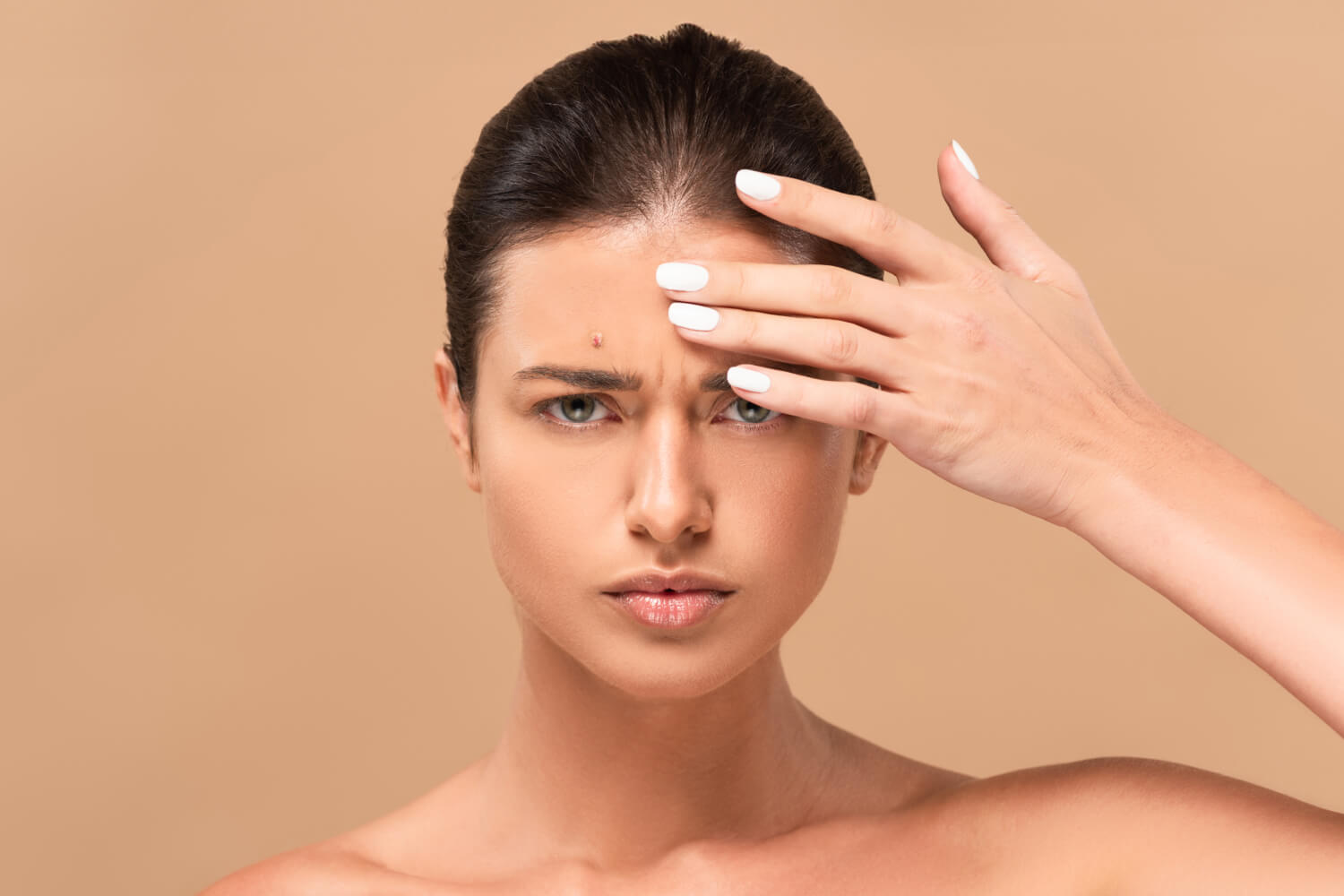
We’ve all had moments where we just can’t figure out our skin: we’ve bought all the right products, we’ve put together a simple and effective skincare routine, and yet nothing seems to work. “Why is my skin so bad, even with a skincare routine?” we’ll ask ourselves, blissfully unaware of all the things beyond the skincare routine that can actually affect the appearance of our skin. If this sounds like you, keep reading: today we’re talking about some common skincare mistakes that you may be making, and which could very well be canceling out the benefits of your skincare routine.
First things first, we’ll help you identify these common skincare mistakes; then, we’ll offer you some solutions to fix them. Some of them are not super obvious, so keep reading and you may find what’s been wreaking havoc on your skin.
Mistake #1: You store your beauty products in the bathroom
Storing your skin care products in the bathroom is one of the worst beauty mistakes you can make; coincidentally, it’s also one of the most common. We know it’s super practical to have everything at hand, but the conditions of your bathroom–gorgeous as it may be!–are quite far from ideal storage conditions for your favorite products.
High temperature and humidity are the big culprits here: the ideal storage situation for your products would involve a temperature below 25ºC and a humidity level below 60%, but these values are difficult to achieve in a bathroom, where you may be enjoying hot showers or blow drying your hair on high heat.
Let’s be clear: you won’t ruin your favorite face cream by leaving it in the bathroom for one day–we’re talking about a gradual, progressive effect. High temperatures and humidity tend to degrade your products more quickly, which means that a face cream that would expire in two years may be ruined within 6 months, even if you’ve never even opened it.
And if you’ve already opened your products, there’s something else to look out for, as you may be “cultivating” unwanted company. Because the products were designed to be stored under ideal conditions, exposure to high temperature and humidity may cause microorganisms (mold or bacteria) to start growing. These can then cause skin rashes or even infections, especially in sensitive areas such as the eye contour.
How to solve it
Store your beauty products in a place that isn’t exposed to direct sunlight or intense temperature variations. Additionally, make sure to keep your skincare away from highly humid rooms in your house–if your walls have mold, so will your skincare products.
A drawer in a cool, dry room may be the ideal storage solution. Buy those cute drawer organizers you’ve been eyeing, store all your skincare there, and keep it shut tight! Some common skincare mistakes are literally this easy to fix.
Mistake #2: You try all the active ingredients at the same time
If you consume a lot of beauty content, you know what things can be like: today you’re listening to a podcast telling you that you should include retinol in your skincare routine, but yesterday you read somewhere that niacinamide was the trending ingredient for dark spots. You already use salicylic acid for your acne-prone skin and azelaic acid, in the evening, for your post-inflammatory hyperpigmentation. Tomorrow there will be a new trending ingredient on your platform of choice, and you’ll be tempted to use that one too.
You place an order and add one of each active ingredient to your cart. When you open the package, you’re so excited to try out your new cosmetics that you use them all, one on top of the other, that same evening. It won’t show for the first couple of days, but then you’ll gradually begin noticing your skin is sensitized, prone to redness, and not achieving the desired results. Are the products to blame here? Probably not. You should, however, reconsider the way you use them.
Skincare is always about choices, not clumping everything together and hoping for the best. If you choose to stack a series of active ingredients in the same routine, not only will the ingredients not be properly absorbed, they can also interact in less than desirable ways. This means you may be canceling the benefits of some ingredients and over-boosting others. This can lead to sensitized skin and underperforming cosmetics.
How to solve it
Instead of stacking active ingredients together like you’re in a chemistry lesson, choose multi-functional products and ingredients. Several ingredients can help with more than just one thing, so find the ones that suit you. Additionally, using powerful ingredients on top of each other rarely is a good idea for your skin barrier, so keep things simple. Choose one or two hero products and stick with them for at least one month. After that period, you’ll have a good idea of whether your chosen products are working, or whether you need to readjust.
Mistake #3: You let your products sit on the shelf for a long time
We know it’s tempting to try all your new products the moment they arrive at your door. Next time you want to do this, however, consider that opening your products means starting the countdown until their expiration date.
Skincare products often have a symbol on the packaging that is related to the “period after opening“, which is the amount of time the product keeps its integrity from the moment you first open it. The symbol looks like a small jar with an open lid and a number inside. That number is the number of months the product is good to use after being opened for the first time.
If, in addition to this symbol, the product also has an expiry date written somewhere on the packaging, you should pay attention to the earliest date, and disregard the other one. For example, if the expiry date written on your product is one year from now, but the symbol indicates a safe “period after opening” of 6 months, you only get to use it for six months in total–even if that period of six months ends well before the expiry date.
On products with a low water content, you can be a little lenient with the “period after opening”, so long as you keep an eye out for color, texture, or scent changes. In products with a high water content, however, it’s important to follow these instructions strictly. This holds especially true if the product is for use in areas prone to infection, such as the eye contour.
How to solve it
The best thing you can do for your favorite products is to use them all up before the “period after opening” ends–don’t save them for a special occasion! This will ensure that you get all the benefits from your products while they are still in perfect condition. Only open products when you intend to start using them and–here’s a pro tip–write the date you opened the product on the bottle and keep an eye on it.
Mistake #4: You skip daily sunscreen
No skincare routine is complete without sunscreen. Not only does it protect you from getting sunburned, it also helps prevent wrinkles and dark spots.
Here at Care to Beauty, we believe that everyone should use sunscreen every day, but there are people for whom this advice is extra extra important–for example, if you do everything for the well-being of your skin, including going for frequent in-office treatments, you need sunscreen to maintain your great results. There is nothing more counterproductive than subjecting your skin to a laser treatment, for example, and then exposing it to the sun!
Additionally, people who deal with skin conditions with an inflammatory component (such as acne or rosacea) can also benefit hugely from using sunscreen every day. Sunlight has an inflammatory component and, by using sunscreen, you can help protect your skin from it.
Finally, we also want to bring up the many benefits of daily sunscreen use: nowadays, sunscreens have such complex and versatile formulas, including soothing, antioxidant, or anti-dark spot ingredients, that they can be considered a true skincare product!
How to solve it
The best way to ensure you use sunscreen every day is to find a sunscreen that you actually enjoy using. If applying sunscreen is a horrible experience for you, you’ll tend to avoid it, understandably. No one wants a terrible product on their face on a daily basis!
We’ve already compiled so many sunscreen lists that we’re positive you can find your favorite on this blog. From sunscreens that won’t burn the eyes, to sunscreens for acne-prone skin (and for dry skin), sunscreens for dark skin, and even a selection of Korean sunscreens, we have everything.
Mistake #5: You don’t change your towels and pillowcases frequently enough
This is one of the most common skincare mistakes when you’re trying to take care of your skin.
Let’s start with the towels: they’re constantly wet, creating an ideal environment for bacteria to thrive. Now imagine you’re dealing with acne and using anti-bacterial products to keep your skin clear–why would you want to risk exposing your skin to bacteria that are growing on your towel? Make sure to switch up your towels on a (very) regular basis in order to avoid this.
Cotton pillowcases are a similar source of contamination, as they tend to collect a significant amount of build-up, including dead skin cells, residue from skincare products, and bacteria.
How to solve it
Exchange your towels and pillowcases frequently. If you can, opt for individual face towels that you only use once and then wash. Lastly, switch your regular pillowcases for silk or satin ones that tend to accumulate less dirt.
There are a few more common skincare mistakes that we could discuss here, but keeping these five under control should give you a great head start! If you’re having doubts on how to choose the right products, why not check out how to build your skincare routine?
Pharmacy Technician & Beauty Writer


